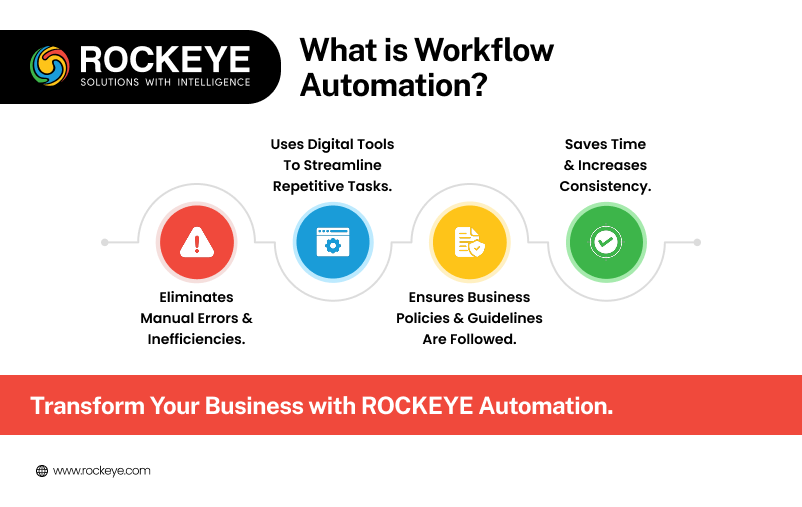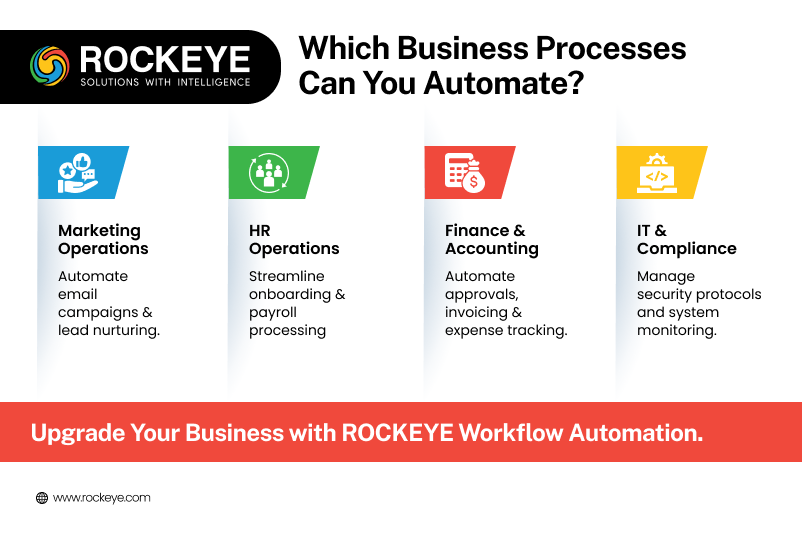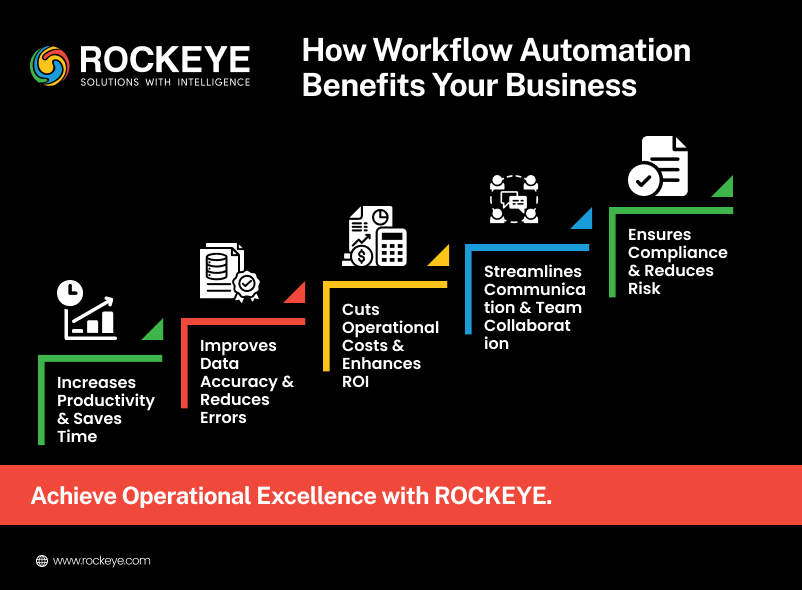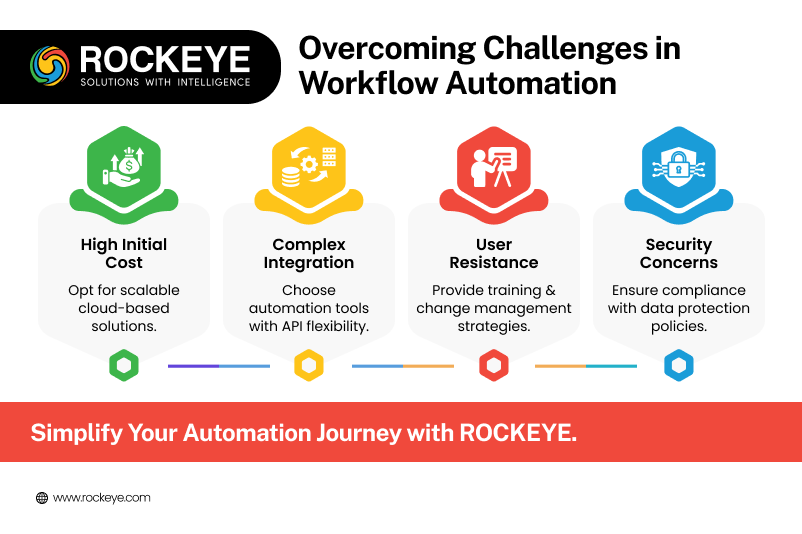Introduction
With the passage of time, the need to make business processes efficient has become dire for all sized businesses. Besides, some tasks which have to be monotonously carried out daily can delay productivity of an organization. This is where workflow automation is reflected over to make business processes organized and better. Moreover, the operations which are significant for daily routine become easier to manage and execute with workflow automation.
This series of automated actions makes workflow productive while removing hurdles caused by daily manual tasks. Now, let us understand what workflow automation actually means and how to implement it into business processes management strategy. The use of technology has become imperative in speeding up business processes through workflow automation.
What is Workflow Automation?

The replacement of manual work while making it automated with the help of digital tools is known as workflow automation. Generally, this process is carried out on a single platform with different features which can simplify the daily tasks within a matter of a few minutes. Workflow automation has the potential to standardize work while ensuring the business policies are followed with the help of business preset guidelines.
The whole idea of implementing this process is to eliminate human errors which are witnessed in daily tasks. The desired outcome can be achieved efficiently at the workplace with the help of workflow automation, thereby, maintaining accuracy and consistency in business processes. Moreover, it becomes easier to streamline business operations without human intervention.
Common Business Processes that can be Automated

Business processes including marketing, HR management and finance are being automated at present using workflow management strategies. Here are some of the important ways through which businesses can attain their goals by automation of common business process on a daily basis:
- Automate your Marketing Operations
The workflow automation enables you to automate your marketing tasks which are assigned and managed daily. It can integrate your email marketing campaigns on autopilot while executing tasks along with email offers. Within a few clicks and scrolls, targets of marketing can be attained within a short span of time. Besides, the manual recurring tasks of marketing can be eliminated and manual errors will be averted with workflow automation. This process is not just for online business, but also, suitable for all sized businesses which aim for better returns on investment in lesser time.
But marketing automation isn’t just for online businesses. With the help of automated email workflow processes, many companies are currently staying connected with their clients with a single interface. From collecting the real-time data from the clients, storing the business details to using the data for further communication, the workflow management automation tools are being relied on by the business owners.
Automated email workflows are being utilized by businesses to welcome subscribers who sign up for their services. Templates of email automation are timely chosen to schedule the mail and send it to the subscribers.
Following are some of the variations of implementing workflow automation in marketing:
- Build relationships
- Get feedbacks
- Lead nurturing
- Improve user engagement
- Automate Human Resources Operations
When it comes to onboarding and conducting training for employees, the HR processes need to be efficient as well as consistent. The manual operations can be time-consuming, hence, using automated workflows on auto-pilot mode can be a significant asset to rely on for your business.
With this automated mechanism of workflow, maintaining a database becomes easier. The manual efforts will no longer be required. In HR, not only the personal information, but real-time information of employees related to insurance systems, medical benefits or expenses’ allowances have to be accurate. But, this is not possible with manual data entry work as it can have a scope of human error. Nevertheless, by automation of HR operations, database management can be efficient and accurate, saving time for staff members. One can run an automated payroll or performance appraisal using workflow automation. Following are some of the advantages of automating the workflow of HR processes:
- Quick processing and data sharing improve work productivity
- Paper-based work can be eliminated, thereby, cutting costs of storage and printing
- Business operations remain compliant with policies determined for the HR department
- Company’s growth gets accelerated due to efficient execution of the hiring process and streamlining of HR processes
- Elimination of manual work allows you to assess HR processes and amend them accordingly
- Automate Accounting and Finance Processes
Are human errors causing an interruption in the smooth management of accounting and finance operations? From pending approvals, calculation based errors, travel expenses moderation and many other tasks of this department which have to be manually managed can be tedious. But, when the workflow automation is implemented, every action can be monitored without any interruption. In fact, logistical errors which can land your company in trouble will no longer be a concern as the automation of accounting and finance processes will maintain accuracy in the data management.
Be it automated approval of travel expenses, approval of pending vacation requests or execution of any other process, the automated workflow will validate the same. Following are the merits of workflow automation for finance and accounting processes:
- Reimbursement process requests and expenses approval can be automatically executed
- Travel requests can be approved automatically
- Invoice and expenses can be settled in an automated way
Why should you Automate your Workflow?

In the modern era, businesses are increasingly using digital systems for monitoring daily activities and data management. This is indeed essential for accessing real-time information without any hassle. The major advantage of automating workflow is that tasks are managed effectively unlike the complicated tedious manual work. Most of all, the workflow becomes efficient further enabling the organization to achieve organizational goals in a smooth and glitch-free manner.
The advanced utility of automation tools has become the dire requisite for enterprises for controlling operations without any mismatch. It in turn assists entrepreneurs in coping up with changing business dynamics.
Following are some of the reasons to rely on workflow automation:
- Productivity: Tracking details of work through manual reports to determine the work quality of employees can be time-consuming. But, with the help of business automation tools, the productivity of the entire team can be readily evaluated along with work progress details.
- Easy to Use: The user-friendly interface of these technologically advanced tools allows you to create and manage tasks easily. All you need to do is get familiar with the business process automation tool for witnessing favourable output.
- Improved Time Management: The regular updates and reminders of managing workflow will ensure that all the targets of the day are attained in a timely way. The deadline of the work accomplishment will not be missed with the chosen workflow automation system.
- Tech Support: When you come across issues, seeking LIVE tech support is the best option. But, if this feature is not offered in the tool, then, you should send an email to the tech support team for assistance.
- Collaboration: In order to avail the utmost benefits from the workflow automation for the team, checking collaboration features in the tools is a must. From LIVE chat, task assigning to messaging, these options should be explored in the interface of the shortlisted tools.
- Employees get empowered to handle their Tasks: With the automation of workflow, employees understand their roles & responsibilities precisely. In fact, management can access their work progress instantly and the employees do not need manual supervision to attain the daily target at the workplace. On the contrary automated workflow management enables the management to oversee the tasks in the dedicated interface. They get sufficient time to plan future business goals with workflow automation.
- Workplace Efficiency: With the help of a customized automated workflow system, the approval tasks can be easily executed. Even if the person is not from a technical background, he can easily use the dedicated options to streamline the processes. Management does not have to manually check every operation. This increases workplace efficiency.
- Cost and Error Reduction: You don’t have to be bothered about the human errors affecting the productivity of your work anymore. The automation of workflow manages the data accurately and enables employees to work without any interruption. Besides, all the costs invested on training or additional resources can be reduced with the help of automating the workflow.
The Pros and Cons of Automating Workflows

According to a McKinsey report, 45% of current paid activities can be automated by today’s technology, an equivalent of $2 trillion in total annual wages. Therefore, it is pivotal to rely on automated workflow management for making each day at the workplace productive while empowering the employees.
The Pros of Automating workflows
Workflow automation brings a number of advantages to businesses. Some of the key advantages of automating workflows are:
- Redundancy rate becomes low: It is easier to track redundancies in the business operations with the implementation of automated workflow and thereby, removing them with automated systems.
- Accountability gets increased: Human errors are removed due to zero human intervention which leads to increased accountability by automating workflow.
- Improved transparency: The workflow becomes transparent and any error in operation can be readily identified. Apart from this, leadership, task status and interruptions in work progress can be easily assessed.
- Productivity level increases: Employees are no more required to follow the daily routine and do repetitive tasks. On the contrary, they can focus on strategic plans.
- Data can be centralized: The data stored in the automated panel of workflow can be accessed by all the employees. The records can also be referred to check the status of leadership within the company.
The cons of workflow automation
Some of the Cons of automating workflows are:
- Initial cost: The automation of workflow has been viewed as a cost reduction factor. But, the initial cost of workflow automation is higher. Depending on the complexity of business process management, the price of software varies.
- Change management: The result of automated workflow is phenomenal and it needs testing as well as continuous testing to experience the effectiveness of the software.
- Implementation scale: On implementing the workflow automation for a large scale business operations, it can lead to unexpected issues. However, automated workflow for small scale as well as phased implementation offers commendable outcomes.
“As machines become more and more efficient and perfect, it will become clear that imperfection is the greatness of man.” – Ernst Fischer
5 Steps to Run an Effective Workflow Automation
In order to make business efficient and productive, automation of workflow is the quicker as well as easier option. Besides, attaining efficiency in executing tasks, consistent performance, accuracy of data management and getting desired outcome are some of the other factors which make workflow automation resourceful.
The point to be addressed is what exactly is the need of automating business processes? To start with, the recurring tasks of business which have to be performed daily can consume lots of time leading to unfulfilled targets of the day. Basically, the manual work of compiling confidential papers in the file, maintaining spreadsheets, checking and reverting to the emails are some of the tasks which can be eliminated from the routine if the automated workflow management has been followed.
With the help of automation, business processes can be streamlined with lesser human intervention. This results in chalking out the chances of human errors. Let’s check out the steps to run an effective workflow automation:
- Identification of Repetitive Tasks
The business segment which has multiple repetitive tasks needs to be identified at the initial step to be considered before investing in workflow automation software. This problem can be identified by forming an in-depth understanding of the business. In order to accomplish this goal, the visual presentation of business such as the use of flow diagrams will be effective. You will be able to assess your business operations better while chalking out the repetitive tasks.
After this, you need to design an appropriate workflow which can improve your current plan by automating repetitive tasks. You can consult with your stakeholders and employees who will use the workflow automation software to finalize the new workflow. Cost-saving and efficient implementation of workflow automation are the benefits you should consider.
- Defining Business Goals
After getting familiar with major issues in workflow management, you should define your business goals as the next step. Keeping current manual operations as the benchmark, these goals need to be defined. The main target should be to reduce the time consumed in achieving deliverables and improving the work processes through optimization of resources to make tasks productive.
With the optimization of resources, you may visualize your staff members to minimize the use of less data entry tasks and in turn, shift their focus to work optimization and work insights overview. Depending on your business goals, you just need to analyse how to achieve them through automation and identify the ways to measure these goals.
- Selection of the suitable Workflow Automation Tool/Platform
After the initial two steps, you need to decide how to execute your business goals to automate your business processes. In order to do this, choosing the best workflow automation solution is an essential segment. The selection of the proper software will give you a quick overview about the solution provider. At present, there is a range of options available in the market for workflow automation. You just need to finalize the one which caters to your company’s business requirements. Many companies have started switching to cloud options that offer flexible accessibility at lower cost.
Is it essential for executing your operations in an automated way? What license or certification is obtained by the software? What is the importance of data security? These are some of the questions to be addressed while finalizing the workflow automation tool for your organization. Furthermore, on the basis of your specific organizational goals, it is advisable to shortlist 3-4 software platforms for workflow automation. After this step, you can check the merits and demerits of the software to take the final call. But, you may need to view the demo of the finalized workflow automation tool as it will be beneficial in taking the practical decision.
You should remember that the software chosen for automating workflow must be user-friendly and easy to understand for your employees
- Training Employees to Use the Platform
Now the next step is to conduct training sessions for the employees to get acquainted with new workflow automation software. In case, there are any modifications in the workflow introduced by the management, most of the employees think them as unnecessary. However, in the case of workflow automation, the software empowers them to be a part of decision-making. This can be possible if the workforce gets trained initially. In addition, making the employees a part of discussion and motivating them to come up with better ideas will contribute towards productivity of the organization.
The significant change in the workflow from manual operations to automated workflow management is a new addition to the company’s work policies. Hence, the team should be trained adequately to help them understand the utility and performance of the software.
- Measuring KPIs to Improve Workflow Management
After the implementation of all the four steps, you are prepared to avail the merits of workflow management software. The users will offer you their feedback on the process based on the effectiveness of the platform they have worked on. Hence, you will be able to measure the KPIs or key performance indicators for improving your workflow.
Over time, constant monitoring and assessment of your automated workflow management will enable you to understand hindrances and thereby, recommend the scope of improvement. Learn more about process improvement methods. Hence, the upgrade in workflow will lead to better performance of the workforce and increased work productivity.
How Can ROCKEYE Help in Automating Workflow?
ROCKEYE is a business automation ERP, aimed at making internal processes of an organization simplified as well as efficient. From monitoring tasks along with their status, visualizing process workflows, checking the performance of the team, and cutting out all the blocks, this is one of the effective process automation tools which makes process management resourceful.
Making work organized and managing recurring workflows have been the foremost advantages of utilizing ROCKEYE for business operations. This tool has a unified dashboard that offers you absolute control over workflow.
Following are the common ways in which ROCKEYE can automate business processes:
- Processes run as collaborative workflows
Business processes can be shared with other users, clients, and teams through ROCKEYE ‘s business automation Suite. - App integration prospects with over 1000 tools to automate tasks
No matter which app you rely on for workflow management, ROCKEYE is one of the popular business process automation tools which can be integrated with over 1000 tools. - Powerful analytics
The real-time details including updates and status of current tasks can be tracked as well as exported with the help of this tool. As a result, the issues in the productivity and output of a team can be assessed.
In short, ROCKEYE is a smart business processes automation tool designed for managing recurring workflows in the simplest way. The best part about this platform is that it can be customized according to business goals.
Conclusion
The growing need of improving productivity at the workplace and empowering workforce while removing bottlenecks in the manual operations have led to automation of workflow. All sized businesses are constantly experimenting with the change in work policies and leniencies in strictness, but, when the workflow automation comes into the picture, the journey towards the attainment of business goals is redirected towards the right path. Since the workflow automation tools have acted as the game-changing elements in today’s business world, it is important to understand organizational requirements before investing on the appropriate platform.
In order to benefit to a great extent, automating workflow by training the employees is the right approach to start with. When they have understood the way to use the software, they can also share their inputs regarding the level of ease experienced by them in automating the recurring tasks. This will altogether improve the efficiency of business process management and churn out the organized tasks automatically without much manual intervention.

FAQs
Q1. What is workflow automation in simple terms?
Workflow automation is the replacement of manual work while making it automated with the help of digital tools. It is generally carried out on a single platform with different features that can simplify the daily tasks within a matter of a few minutes.
Q2. How does workflow automation help businesses?
It helps in eliminating human errors, maintaining accuracy and consistency in business processes, and streamlining operations without human intervention. It further enables the organization to achieve its goals in a smooth and glitch-free manner.
Q3. Which business departments benefit the most from workflow automation?
Marketing, HR management, and finance are the major departments where workflow automation is implemented to attain daily targets efficiently and without manual errors.
Q4. Can marketing operations be automated using workflow automation tools?
Yes, workflow automation enables businesses to automate daily marketing tasks, execute email campaigns on autopilot, and stay connected with clients through a single interface.
Q5. How does workflow automation improve HR processes?
Automated workflows help in onboarding, training, maintaining accurate databases, automating payroll and appraisals, and eliminating paper-based tasks, which in turn accelerates the company’s growth.

